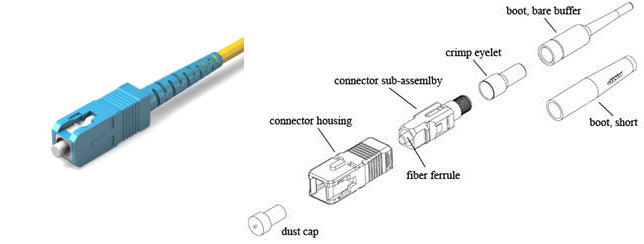Being a part of the fiber patch cable, the fiber optic connector is utilized to achieve accurate and precise connections of the fiber ends. Now there are many kinds of fiber optic connectors in the market, such as ST, FC, SC, LC and so on (as shown in the following figure). Since the fiber cable transmits pulses of light instead of electrical signals, it is important to choose a good fiber optic connector that aligns microscopic glass fibers perfectly in order to allow for communication. This post will introduce fiber optic connector in an alternative way.

Though the mechanical design varies a lot among different connector types, the most common elements in a fiber connector can be similar. That’s to say, the connector is mainly composed of fiber ferrule, connector sub-assembly body, connector housing, fiber cable and stress relief boot. The following figure takes SC connector as example to show the general components of the connectors.

Different kinds of optical fiber cables may need different connectors. Seen from the types of optical fiber, the fiber optic connectors may be loosely classified into standard fiber optic connectors, small form factor fiber optic connectors and ribbon fiber connectors. These family types of fiber connectors sometimes may overlap with each other.
Generally having a ferrule of 2.5mm, standard fiber optic connectors are connectors commonly used in the fiber network. They can be both simplex and duplex and available in single mode and multi-mode fibers. ST, FC, SC, FDDI and ESCON are all standard fiber connectors. But they also differ from each other. ST connector is the most popular connector for multi-mode fiber optic LAN applications. FC connector is specifically designed for telecommunication applications and provides non-optical disconnect performance. SC connector is widely used in single mode applications for its excellent performance. FDDI connector, which is a duplex multi-mode connector, utilizes two 2.5mm ferrules and is designed to used in FDDI network. ESCON connectors are similar to FDDI connectors, but contain a retractable shroud instead of a fixed shroud.
To meet the demand for devices that can fit into tight spaces and allow denser packing of connections, a number of small form factor fiber optic connectors have been developed since the 1990s. In this type of small form factor fiber optic connectors, some are miniaturized versions of older connectors, built around a 1.25mm ferrule rather than the 2.5mm ferrule. For example, the LC, MU, E2000 connectors. While the others are based on smaller versions of MT-type ferrule for multi-mode fiber connections, or other brand new designs. For example, the MT-RJ connector, which has a miniature two-fiber ferrule with two guide pins parallel to the fibers on the outside. Its overall size is about the same as a RJ45 connector.
MTP and MPO are compatible ribbon fiber connectors based on MT ferrules which allow quick and reliable connections for up to 12 fibers. Since the MTP product complies with the MPO standard, the MTP connector is an MPO connector. Along with the MTP patch cables (for example, MTP-MTP fiber trunk cable), MTP connectors can upgrade the 10G network to 40G/100G.
The fiber optic connector is an essential part in fiber optical network. As the popularity of fiber optical network, about 100 fiber optic connectors have been introduced to the market. FS.COM is the main professional fiber optic products supplier in China, and we offers various kinds of fiber cable connectors, especially the commonly used FC, LC, SC, ST and MPO connectors.


